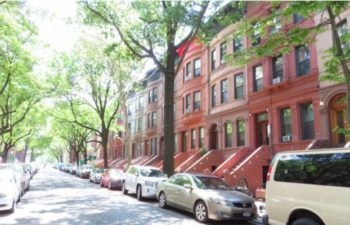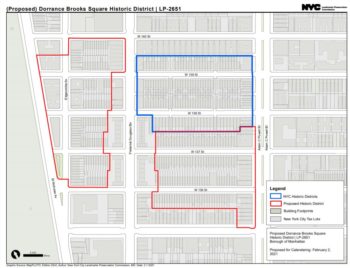
Rowhouses within the proposed historic district. Image Credit: NYC LPC
The proposed district is in two sections and prominently features many rowhouses. On February 2, 2021, the Landmarks Preservation Commission voted to calendar the Dorrance Brooks Square Historic District in Harlem for future designation. The greater proposed historic district represents the area’s significant connection to the Harlem Renaissance and advancements in politics, education, healthcare, literature and culture.
The proposed historic district is in two sections (see map). The western part runs from West 140th Street to the north, West 136st Street to the south, St. Nicholas Avenue to the west and an eastern border that runs one block down Frederick Douglass Boulevard between West 139th Street and West 140th Street, and then runs behind the buildings facing Frederick Douglass Boulevard from West 136th Street to West 139th Street. The eastern portion of the district runs from West 137th Street to the north, West 136th Street to the south, a border that runs behind the buildings on the eastern side of Frederick Douglass Boulevard on the west and Adam C Powell Boulevard to the east. The eastern portion of the proposed district is adjacent to the St. Nicholas Historic District. The buildings along Frederick Douglass Boulevard that are excluded from the proposed district were built in the 1990s and do not maintain the streetscape or historic significance featured throughout the proposed district.

The map of the proposed historic district, outlined in red. Click image for enlarged version. Image Credit: NYC LPC
Dorrance Brooks Square was dedicated in 1925 in honor of Dorrance Brooks, a Black serviceman who died in action while serving in World War I. This was the first public place in the city to honor an African American. The Square, located between West 137th Street to the north, West 136th Street to the south, St. Nicholas Avenue to the west and Edgecombe Avenue to the east has been the site of many political protests starting in the 1920s.
The area developed more with the addition of elevated railway service along Frederick Douglass Boulevard (then known as Eighth Avenue) in 1868. Further development along St. Nicholas and Edgecombe Avenues occurred in response to the new IND 8th Avenue subway line (now the B and C trains) in 1932. The buildings within the proposed historic district consist of row houses primarily in the Renaissance Revival, Romanesque Revival and Queen Anne styles. At the start of the 1900s, African Americans who were pushed out of other neighborhoods in Manhattan due to discrimination moved to Harlem, and by the 1920s, the neighborhood became a community for middle-class African Americans.
The proposed historic district was home to many prominent and historical residents and institutions. Prominent literature and arts figures included essayist W.E.B. DuBois, sculptor Augusta Savage, and actress Ethel Waters. Artists like Savage operated studios within the district, like the Uptown Art Laboratory and the Harlem Artist Guild. The Harlem West Side Literary Salon at 580 St. Nicholas Avenue (also called “580”) was hosted by Regina Anderson, Luella Tucker and Ethel Ray Nance. 580 provided a space to help foster careers of many Harlem Renaissance artists including Countee Cullen and Langston Hughes.
The area also featured two small hospitals, the Vincent Sanitarium and Hospital and the Edgecombe Sanitarium, which were founded by African American doctors to serve the local community. The area was also home to Dr. May Edward Chinn, the sole Black female doctor practicing in 1930s Harlem.
Landmarks will hold a public hearing on the proposed historic district in the near future.
By: Veronica Rose (Veronica is the CityLaw fellow and a New York Law School graduate, Class of 2018.)


Dr. James Lancelot WILSON is another formidable figure in Harlem you might consider noting. His biography and that of his close friend Dr. Louis T. WRIGHT are included in the recent (2016) book “African American Doctors of World War I, The Lives of 104 Volunteers.” The important role of the Edgecombe Sanitarium is also cited.